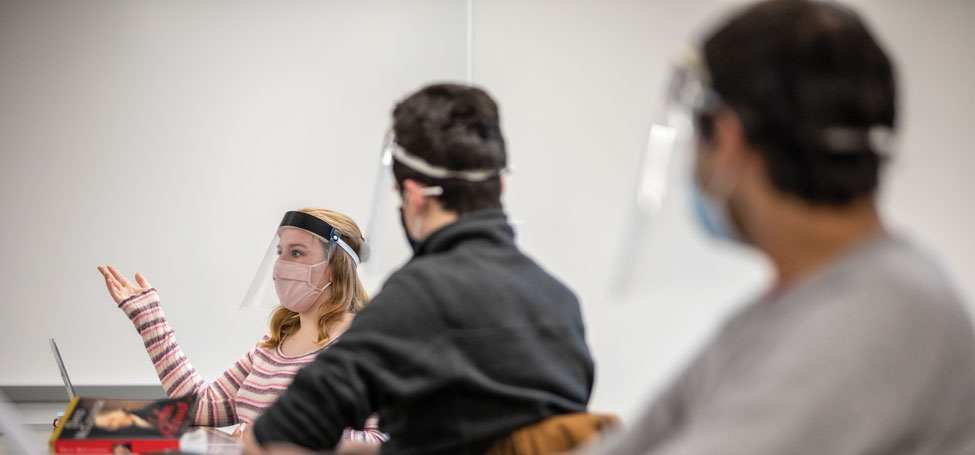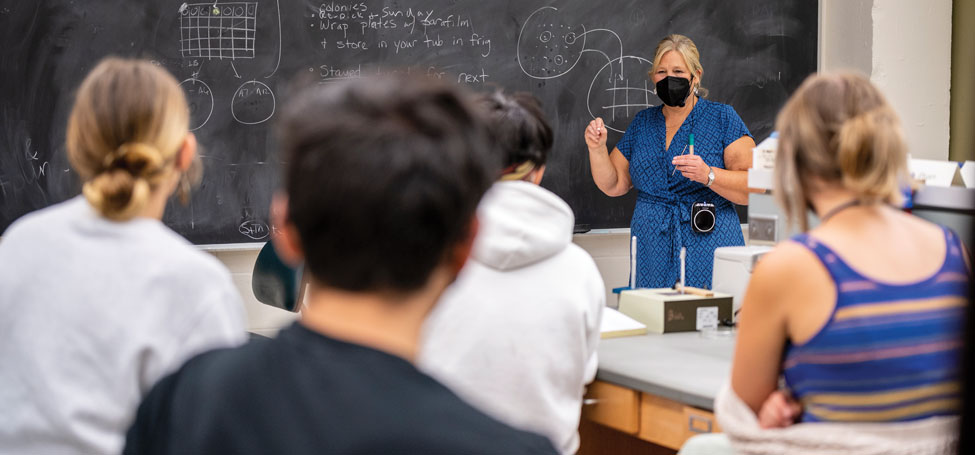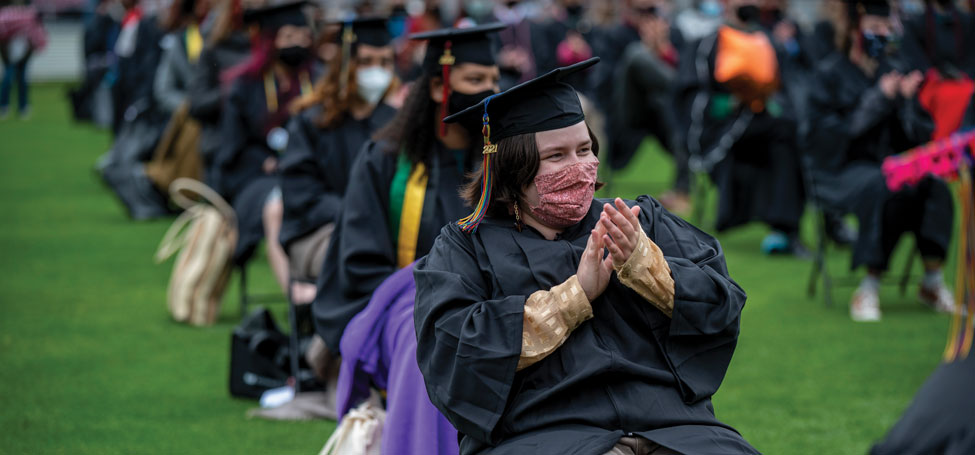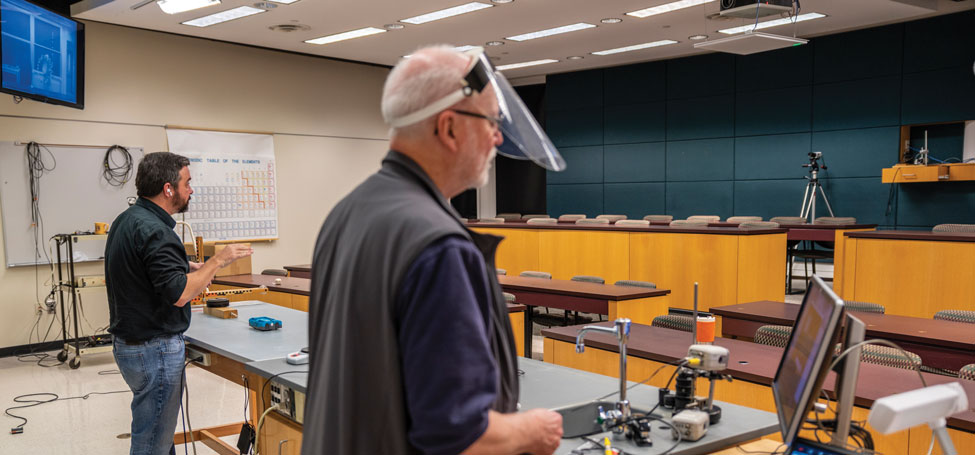Adapt, Change, Think Differently
As students, faculty, and staff returned to campus in August 2021, eager for a “normal” year — or as normal as it gets given that the coronavirus pandemic is still with us — the ways in which the dramatic changes and challenges of the past 18 months affected our community have become more apparent. While initially the behind-the-scenes work was primarily done to help keep everyone as safe and as engaged as possible, it soon became obvious that some of these changes will continue to be of benefit to Grinnell in the long run. Here is a quick look at some of the actions of the past year and a half and their impacts.

Keeping the focus on people
Imagining disaster scenarios and how to respond to them “is not always seen as an optimistic role,” says Heather Cox, director of emergency management and risk mitigation. Her attention to plans, exercises, and improvements helped Grinnell address the many different challenges presented by the pandemic.
She compares the effort to leading a band. She doesn’t have to know every note the saxophone plays, but she knows when it’s supposed to play.
In spring 2020, the focus was on getting students home safely and effectively teaching and working remotely. Over time, though, Grinnell's response evolved. For the 2020–21 school year, the focus shifted to allow some students back on campus for 7.5-week terms, while many others continued learning from a distance.
For Cox, who’d started working at Grinnell a little over a year before the pandemic, the experience has caused her to rethink her approach to emergency response. “Trying to have a cookie-cutter operations plan doesn’t work for Grinnell,” she says. What was more useful was identifying people with the skills needed, regardless of job titles. “People got to partner differently,” she adds. “They built new relationships. Hierarchies came down. Silos came down.”
Going forward, Cox knows Grinnell is better prepared. One thing that hasn’t changed: “The focus on people is what the College does very well.”
Dining gets creative
The staff in Dining Services may well have experienced the most changes to operations during the pandemic. The critical nature of food service demanded that they be creative in order to keep students and staff safe.
Their methods of serving food changed several times: from “grab-and-go” meals to meal delivery outside students’ residence halls to masked and socially distanced students picking up food inside the Marketplace.

Changes occurred behind the scenes, too. Before vaccines were available, they reorganized their staff so that they worked in teams — nine or 10 people per team. The team approach allowed for more physical space between workers since fewer staff members were working at any one time. If one person on a team tested positive, another team could step in and take over while the first team quarantined, which happened once.
During the 2020–21 school year when fewer students were on campus, cooking for 10–12% of the typical number of students was a major change. Scott Turley, executive chef, says, “I think it pushed us to put together menus that could carry out well and still be very edible after they’ve been in the container for maybe as long as a half hour or so. It also pushed us to change the way we think about production, because the cooks were used to cooking loads of food as fast as we can go.”
Helping faculty and students go virtual
For Grinnell, the pivot to teaching fully online in spring 2020 and throughout 2020–21 posed significant pedagogical and technological challenges to academic continuity — especially for faculty and students unused to an online learning environment.
“The transition was ultimately successful, but not without struggle,” says Mo Pelzel, director of academic technology and head of the Digital Liberal Arts Collaborative (DLAC), a unit within the Center for Teaching, Learning, and Assessment.
DLAC staff ran virtual workshops and town halls for faculty to discuss the nitty gritty of online teaching, such as how to engage students, design assignments, estimate workloads, and more. Training was also offered for the College’s learning management system and other platforms and applications. DLAC partnered with other departments, such as Information Technology Services, to make new software applications available for faculty and students to use online.
“We encouraged faculty and students to adopt an approach of technological simplicity and minimalism,” Pelzel says.
During the pandemic, faculty and students increased their digital literacies and skills out of necessity, but Pelzel also sees a silver lining. Some of the positive gains can be carried forward. “We can become more thoughtful about incorporating digital and online practices into teaching and learning.”
For example, he says, online conversations can be a helpful addition to classroom experiences because they “can allow for more composed and reflective discourse and give students who may be more shy in the classroom a better opportunity to make their voice heard.”
Maintaining connections
Development and Alumni Relations (DAR) staff love helping foster alumni ties, so when in-person events were wiped off the calendar during the pandemic, they got creative about helping people feel connected to Grinnell.
The public phase of Grinnell’s largest fundraising campaign launched in October 2019, just a few months before the virus started its march around the world. Staff had to radically rethink the campaign strategy and shift conversations online. To keep Grinnellians feeling connected, they created a series of videos in which individual alumni told their own powerful stories about the impact Grinnell has had on their lives.
Major events such as Alumni Reunion and Alumni College were completely rethought and then went virtual. In some cases, participation rose. Alumni College usually attracts about 100 people in person. Online in 2020-21, more than 1,100 people participated in some part of it.
DAR also hosted a few new events virtually, such as a trivia tournament, an alumni geography bee, and an alumni spelling bee. The virtual spelling bee attracted 65 alumni participants in the preliminary round. The championship round, with 15 alumni spellers, was livestreamed. “It was a nail-biter!” says Jaci Thiede, vice president of development and alumni relations. All three events will become annual online events.
“Virtual works for a lot of people,” Thiede says. She anticipates DAR will continue using virtual events as a way of keeping Grinnellians connected.
Addressing financial needs and recruiting
Investing in Students
$3.7 million
awarded through grants
$2.5 million
financial aid awarded to meet new financial need
$2.5 million
allocated to support technology
“Our staff had to quickly adapt to an entirely new way of approaching their work,” says Joe Bagnoli, vice president for enrollment and dean of admission and financial aid. “Admission relies heavily on in-person interaction and relationship development, and we had to find ways to achieve this through virtual encounters.”
Financial aid staff helped distribute special aid, including a COVID-19 Response Grant of $2,500 for every eligible student, in response to the pandemic. A total of $3.7 million was awarded through these grants and an additional $2.5 million in financial aid was awarded to meet new financial need among student families that was not covered by the Response Grant. Additionally, 50% of work-study awards were replaced with grants ($1 million), and more than $2.5 million was allocated to support technology, designated funds for emergency use, and to offset new living expenses for students who returned home unexpectedly. In total, the College invested more than $10 million in unscheduled financial aid to help students and their families weather the initial storm of the pandemic.
When it became clear that the pandemic comet would have a long tail, the College decided to eliminate student loans for new and continuing students eligible for need-based financial aid, replacing loans with grants and scholarships. This no-loan initiative, endorsed by Grinnell College’s Board of Trustees, became effective Fall 2021 for all new and continuing students eligible for need-based financial aid. The no-loan initiative will allow most Grinnell students to graduate debt-free and has implications far beyond the pandemic.
To engage prospective students who could no longer visit campus in person, the admission and financial aid staff developed a comprehensive suite of virtual materials targeting every phase of the college search process. This included on-demand content like videos highlighting student life, academics, and the town of Grinnell as well as virtual, interactive content such as staff-led information sessions, interviews, and high school visits; live virtual tours led by current students; and virtual half-day programs that mirrored large-scale on-campus visit programming. A test-optional admission practice was adopted for two years in response to test center closures. The sum of these efforts and the agile response of everyone in the enrollment division was remarkable.
Fall 2021 saw a record-breaking number of first-year applications (10,513) and the lowest admit rate in the College’s history (10.5%). The 2021 enrolling class, in addition to representing a variety of interests and talents, comes from 31 different countries and 47 U.S. states; and students who identify as Black, indigenous, and other people of color make up 27% of the new class.
“Our team exhibited tremendous commitment, flexibility, work ethic, and positive attitudes over the past year and a half,” says Bagnoli. “It was clear that everyone cared deeply about our prospective students throughout this pandemic and wanted to help them through an unprecedented college search and application process.”
Bolstering community and community health
With many students no longer on campus, the Office of Student Affairs had to quickly adjust and reimagine much of its work to ensure the needs of students were met as they adapted to online learning or radically altered in-person classes — often in learning environments that were far from optimal.
“For a student-facing division dedicated to engaging students and their learning outside the classroom, the pandemic presented many opportunities to consider how we do that,” says Sarah Moschenross, vice president of student affairs. “It was definitely odd not to have all of our students on campus, but our work felt more relevant than ever. We worked in close partnership with our academic and professional colleagues in considering the student experience and how we would approach the year, collectively, for the College.”

Student affairs established a student advisory group to work with the office in partnership as they made decisions affecting students. That group worked alongside staff and faculty to innovate, prioritize equity, and think through every decision and possible unintended consequences. Staff also worked to move their cocurriculum online to continue providing academic support, developing identity, and creating a sense of belonging and connection in a virtual world.
The Center for Religion, Spirituality, and Social Justice kept the food pantry and lending library afloat while also finding ways for students to worship together virtually and eventually in person and socially distanced. The student involvement team pivoted to virtual program offerings to provide students social time together after classes. The intercultural affairs team kept important and established groups like the Black Womxn’s Group and Men of Color Empowered and Engaged together by meeting virtually and continued to bring programming to the community throughout the pandemic. New Student Orientation and Parent Orientation were both moved to an online format, as well as a number of webinars that helped the office reach more students, parents, and families than it could have in person on campus.
Many team members also remained on the ground every day with students, faculty, and staff, including the Student Health and Wellness (SHAW) team, campus safety, and residential life. For that to happen, the office needed to quickly rewrite protocols with a public health lens and to create procedures for establishing and operating a testing clinic to monitor for COVID-19 exposure in the campus community before vaccinations were widely available.
Mental health counselors and nurses remained available and continued to see students throughout the pandemic, though most did so in a virtual format that was quickly introduced when students had to leave campus. They also expanded access by partnering with Virtual Care, which allowed students living domestically to have 24/7 access to physicians and mental health experts no matter where they were located.
“I think it has to be said that the staff gave all of themselves to this endeavor,” says Moschenross.

Strengthening ties with neighbors
The Office of Community Enhancement and Engagement worked collaboratively with partners on campus and in town to help ensure the collective resources of the community were leveraged toward the common goal of providing relief and support for the city of Grinnell.
“At the very beginning of the pandemic, our office began pulling together other local funders in the community to meet weekly and get a sense of what everyone was being asked for and how we could coordinate to best support emerging community needs,” says Monica Chavez-Silva, vice president of community engagement and strategic planning.
To provide assistance to medical workers in the community, the College contributed to UnityPoint Health Grinnell Regional Medical Center’s Health Care Heroes Fund and also helped provide safe housing options for health care workers in houses that students were no longer occupying.
Reaching out directly to residents of Grinnell with food assistance programs was also a priority. At the beginning of the pandemic, local volunteers and organizations including Grinnell College formed the Grinnell Food Coalition to address immediate food insecurity. The coalition created free vouchers that could be used to pay for food at any local grocery store. In addition to the approximately $324,000 worth of grocery vouchers distributed to community members, more than 100 volunteers handed out nearly 7,300 boxes of food (with an estimated $275,000 value) to families free of charge. In total, nearly $600,000 worth of food was distributed at no cost to recipients.
As the College continues with an in-person school year after such a long period of separation and hardship, the Office of Community Enhancement and Engagement continues to collaborate with partners to support the community. The new #GrinnTogether initiative hopes to encourage the community to come together with kindness and empathy to rebuild social ties following the incredible challenges of the past year. An event calendar, directories, and a list of community resources can be found at GrinnTogether. [Ed. link removed as the site has been removed from the Grinnell Chamber of Commerce. July, 27, 2022]

Lessons learned
While the pandemic created myriad problems and challenges for the College and the community of Grinnell, it also created unexpected opportunities for Grinnellians to step up and make a difference.
Whether it was assisting students in developing the skills needed to learn in a new format, encouraging and supporting faculty who reinvented their teaching methods, or helping community members stay healthy and connected, College leadership, faculty, staff, and students took action that helped address the pandemic’s immediate challenges. And, true to form, they did so with purpose, passion, and a tireless dedication that kept our academic community not only moving but evolving and growing in ways that will impact the College for generations to come.

